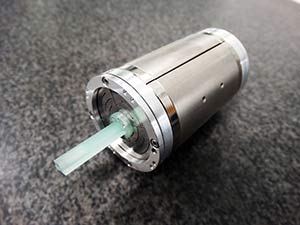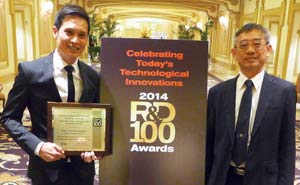
The flexure-based electromagnetic linear actuator (FELA) designed by researchers at the A*STAR Singapore Institute of Manufacturing Technology (SIMTech) won a 2014 R&D 100 award.
© 2014 A*STAR Singapore Institute of Manufacturing Technology
In 2003, A*STAR research engineer Daniel Teo Tat Joo made a shrewd observation while developing high-precision mechanical stages with large ranges of motion. Stages are mechanical devices that are used, for example, to position and move slides under a microscope. To perform high-precision movements, they use actuators, which convert energy into motion. But Teo observed that no actuators had been developed that were capable of both nanometer-resolution positioning and millimeter-scale movement, or stroke. “This was a crucial gap in precision engineering,” Teo explains.
This discovery inspired Teo to develop an actuator with a high positioning accuracy and a millimeter stroke range that could be used in cutting-edge medical and manufacturing equipment. Within a year of working at the A*STAR Singapore Institute of Manufacturing Technology (SIMTech), Teo came up with the idea for a new class of nanopositioning actuators — flexure-based linear actuator, or FELA for short. “FELA is a marriage between an electromagnetic driving module, which is governed by Lorentz-force actuation, and a flexure-based bearing,” explains Teo. In 2004, he took up a SIMTech-funded PhD scholarship to conduct fundamental and theoretical research to enhance the performance of this patented technology and ensure that FELA realized the triumvirate of controllability, motion repeatability and reliability.
To achieve this goal, Teo needed to develop a system capable of performing constant and predictable movements without unexpected jerks. He first designed a new magnetic circuit with a constant magnetic field to ensure that the force generated by the electromagnetic driving module varied linearly with the current over the entire stroke range.
Another challenge was that flexure-based bearings behave nonlinearly (and highly uncontrollably) because they use elastic bending to generate large movements, or deflections. To overcome this problem, Teo constructed a theoretical model that helped him design a flexure-based bearing with a linear stiffness that was capable of generating large deflections.
He developed a prototype in 2005, which boasted a positioning resolution of 10 nanometers and a traveling range of 5 millimeters. This prototype was then successfully integrated as an essential component of a high-precision manipulator for facilitating movement in a process known as ultraviolet nanoimprint lithography.
Soon FELA was in demand for various other applications, including automated needle insertion and as components in alignment systems for optical fiber transceivers. “Its simple and low-cost control architecture, as well as its maintenance-free and inexpensive bearings, make FELA a cost-effective solution for a range of industries,” explains Teo.

Daniel Teo Tat Joo (left), inventor of FELA, and Lim Ser Yong (right), executive director of SIMTech.
© 2014 A*STAR Singapore Institute of Manufacturing Technology
In 2014, FELA was recognized as a significant global innovation by the R&D 100 Awards, sometimes dubbed ‘the Oscars of invention’; past winners include the compact disc, ATM and halogen lamp.
“[FELA] offers a new generation of cost-effective, high-precision systems for the precision engineering industry,” notes Lim Ser Yong, executive director of SIMTech. The award is “a reflection of SIMTech’s research strategy to address challenges and issues faced by industry.”
Teo’s ambitions for FELA do not end there — he is actively trying to refine its precision to subnanometer and picometer levels and expand its stroke range to the meter range. Many issues need to be overcome to achieve this, such as magnetic field interference and environmental disturbances. However, Teo is looking forward to the challenge. “With many uncertainties and perhaps also some new phenomena, I am very excited about what I can discover and present to the research community in the future,” he says.
About the Singapore Institute of Manufacturing Technology
The A*STAR Singapore Institute of Manufacturing Technology (SIMTech) develops high-value manufacturing technology and human capital to contribute to the competitiveness of Singapore’s industry. It collaborates with multinational and local companies in the precision engineering, electronics, semiconductor, medical technology, aerospace, automotive, marine, oil and gas, logistics and other sectors.



